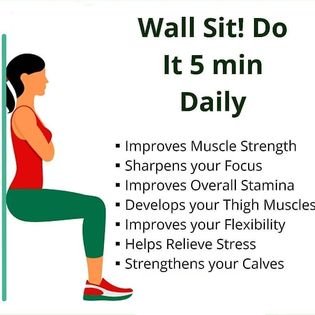Wall sits are a simple yet effective isometric exercise that primarily targets your quadriceps (the muscles at the front of your thighs) but also engage your hamstrings, glutes, and calf muscles. Wall sits are an excellent way to build lower body strength and endurance. Here’s how to perform a wall sit:
- Find a Wall: Look for a sturdy, flat wall or vertical surface where you can perform the exercise. Make sure there’s enough space for you to sit with your back against the wall and your knees bent at a 90-degree angle.
- Stand Tall: Stand with your back against the wall, with your feet about shoulder-width apart and a little distance away from the wall.
- Lower Yourself: Slowly slide down the wall by bending your knees, keeping your back straight. Your knees should be directly above your ankles, and your thighs should be parallel to the ground. Your feet should be flat on the floor.
- Hold the Position: Hold this position for as long as you can. Beginners might start with 20-30 seconds and gradually work their way up to a minute or more as they get stronger.
- Proper Form: It’s essential to maintain proper form throughout the exercise. Your back should be flat against the wall, and your knees should not extend past your toes. Keep your core engaged and breathe regularly.
- Push Through Your Heels: Make sure your weight is evenly distributed through both heels. This will help you engage your quadriceps and prevent excessive strain on your knees.
- Challenge Yourself: As you progress, you can make wall sits more challenging by increasing the duration, adding weights (holding a dumbbell or kettlebell), or changing your stance (e.g., single-leg wall sit).
- Rest and Repeat: After holding the wall sit for as long as you can, slowly stand up and rest. You can repeat the exercise for multiple sets.
Wall sits are a great addition to lower body workouts, and they can help improve leg strength and endurance. They are often used in training programs for various sports, including skiing, cycling, and basketball, as they mimic the isometric demands of these activities. As with any exercise, it’s important to start at your own fitness level and gradually increase the intensity to avoid injury. If you have any pre-existing medical conditions or concerns, it’s a good idea to consult with a fitness professional or healthcare provider before beginning a new exercise program.
